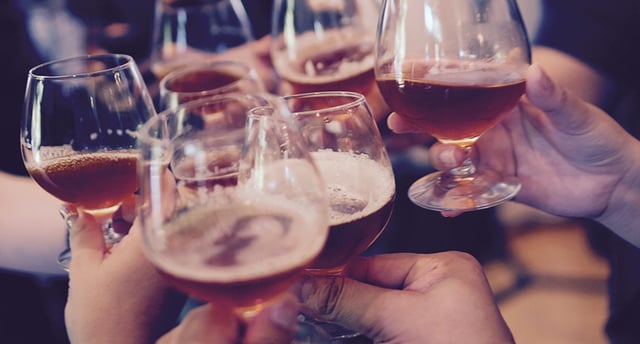Writing a marketing plan for your restaurant can seem like a tedious job, but that really depends on how you do it. There is no reason you should be writing an elaborate 15-page document if you and your team are never going to read it. The more you write, the more you're likely to repeat yourself, or overanalyze your strategies.
The key to a good annual marketing plan (because you should definitely revisit your plan every 12 months) is conciseness.
In this post, I’m going to break down the key elements of a good restaurant marketing plan. I’m also going to provide you with a simple template that you can use to plan out your promotions for the year ahead.

What is a marketing plan?
Think of your marketing plan as an action plan for the next 12 months. It should outline every event and promotion that you intend to run before the end of December, and the outcomes you would like to see as a result.
By outlining your promotions in advance, you’ll be far less likely to go over your budget on unforeseen marketing expenses.
What are the main components of a marketing plan?
There are a few key things to include in your plan, regardless of how you put it together. They are:
- Your goals for the year
- Your annual marketing budget
- A calendar of your intended events and promotions
- The strategies you plan to use
- The outcomes you hope to achieve
I’ll break these down further in the summaries below.
1. Your goals for the year
Before you start planning your events and promotions, it’s important to define your overall marketing goals for the year. These should be measurable so you can gauge how far you’ve come over that 12-month period.
Here are a few goals to consider:
- Increasing your yearly revenue by [x] amount
- Increasing online bookings by [x]
- Increasing hits to your website by [x]
- Increasing your conversion rate (the proportion of website visitors who turn into bookings) by [x]
- Increasing your Twitter/Facebook/Instagram following by [x]
- Increasing your newsletter subscribers by [x]
- Increasing mentions of your restaurant in the media by [x]
- Increasing positive reviews on TripAdvisor/Yelp/Zomato by [x]
2. Your annual marketing budget
Setting an annual marketing budget can be difficult, because there’s no way to know how successful your promotions are going to be – you can only guess. It’s commonly accepted that you should spend from 1 to 10% of your sales on marketing, though this really depends on what you can afford and how established your restaurant is.
When you’re coming up with an annual figure, make sure you take additional expenses like hiring freelancers, attending marketing seminars and other training into consideration.
From there, decide what percentage of your budget should be allocated to different advertising mediums. Consider what’s worked best for your restaurant in the past. If you’re gaining traction through Facebook, for example, then focus more of your spend on that.
According to the 2015 State of Marketing report, 68% of small businesses found email marketing and social media listening to be their most effective marketing strategies, closely followed by social media engagement (67%). In other words, a lot of small businesses are putting their faith in social media this year.
3. A calendar of events and promotions

In order to plan which promotions you would like to run, draft out a calendar of significant public holidays and local events. From there, consider which events you would like to turn into promotions, based on your customers and how appropriate the event would be for your restaurant. Look out for slow months where an unusual event could boost revenue.
Here’s an example calendar based on a restaurant in Melbourne, Australia:
|
January: New Year’s Day (January 1), Australia Day (January 26)
February: Valentine’s Day (February 14)
March: Melbourne Food and Wine Festival (March 4-), Labour Day (March 14), St Patrick’s Day (March 17), Good Friday (March 25), Easter Saturday (March 26), Easter Sunday (March 27), Easter Monday (March 28).
April: April Fools’ Day (April 1), Earth Day (April 22), ANZAC Day (April 25)
May: Star Wars Day (May 4), Mother’s Day (May 8)
June: LGBT Pride Month
July: Christmas in July, Melbourne International Film Festival (July 28-)
August: International Beer Day (August 5)
September: Father’s Day (September 4), Oktoberfest (September 17-), AFL Grand Final Friday (September 30)
October: International Coffee Day (October 1), Halloween (October 31)
November: Melbourne Cup Day (November 1), Remembrance Day (November 11)
December: Christmas Eve (December 24), Christmas Day (December 25)
|
In this calendar, you should also include a section for regular weekly or monthly promotions, like happy hour and cheap Tuesdays, so you can factor them into your budget.
4. The strategies you plan to use
Once you’ve decided on your promotions, break each one down so you can outline a more detailed strategy.
You’ll want to consider who your advertising campaign will target, what method of advertising you will use, and how you will measure its effectiveness using metrics tools.
Here’s an example:
|
Promotion: Valentine’s Day dinner (6 course degustation) / $120 per person.
Audience: Social media followers.
Purpose of Promotion: To attract 60 confirmed bookings.
Marketing Channel(s): Facebook and Instagram paid advertising.
Budget: $ on graphic design, $ on Facebook advertising, $ on Instagram advertising = $ overall budget.
Team Responsibilities: Emma (Marketing Manager) – social media posting and measurement; Claire (Designer) – graphic design of ads; Tom, Erin, Adam (service staff) – in-house promotion to customers.
Deadlines of Note: Graphic design to be completed by [x] date.
Metrics to Measure: Click through rate, cost per click, number of bookings.
|
5. The outcome you hope to achieve
It’s really important to define a single, realistic goal for each promotion. Don’t just say “I want to attract more customers”, be specific about how many bookings you need to achieve a profit for that event, i.e. "I want to attract 60 confirmed bookings."
It’s also important to acknowledge any obstacles that could get in your way so you can plan around them. For example, competing restaurants might be offering a similar event on the same day. So what can you do to make your promotion stand out? Or what method of advertising can you use to reach a wider audience?
There are no hard and fast rules when it comes to writing a marketing plan for your restaurant. At the end of the day, it should be a document that you feel comfortable reading and referring to on a regular basis, so map it out in a way that makes sense to you.
Get Typsy updates straight in your inbox! Sign up to our newsletter now.